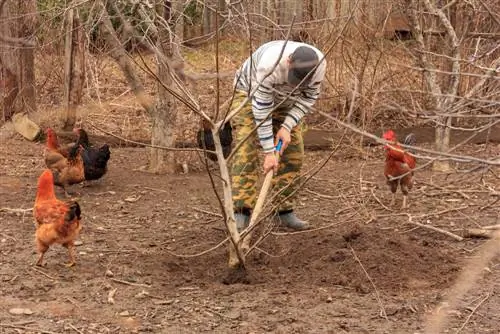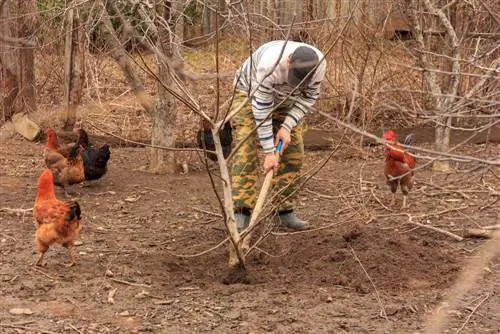- Author admin [email protected].
- Public 2023-12-16 16:46.
- Last modified 2025-06-01 06:02.
Walnut trees are strong taproots that only show a few lateral and fine roots in the upper area. This is why they are difficult to transplant. While it is still relatively possible to move young trees, it is better not to transplant walnut trees that are already higher than two meters. Otherwise, you will have to accept years of care and often even a partial loss of the crown. If you still have to risk it, for example due to impending legal conflicts, it is best to follow the short instructions in our guide.

How to properly transplant a walnut tree?
To successfully transplant a walnut tree, you should do it in late autumn when the tree is leafless. First dig the new planting pit, dig up the tree with plenty of balls, place it in the new planting hole, fill it with soil, water and finally tie it securely to a post.
The right time to transplant
Repot your walnut tree in late autumn when it no longer has any leaves. Then the plant has time over the winter to get used to its new location without having to immediately draw excessive amounts of water.
Relocating a walnut tree - this is how it works
Important preliminary note: The goal when transplanting is to disturb the walnut tree as little as possible.
- First dig the new planting pit.
- Place a stake in the pit. This stake is essential so that the relocated tree does not wobble in the wind. The stake also relieves the plant as it grows.
- Dig up the walnut tree with plenty of bales. The taproot is very difficult to cut - it's best to try to do it by stabbing it sideways with a sharp spade (€29.00 on Amazon) or, if necessary, with an ax. Dig out the bale at least 50 centimeters deep. This requires some strength and endurance, so be aware of that.
- Once you have freed the walnut tree, move it along with the soil at the roots into the new planting hole. Make sure that the tree does not end up any lower than before (at its old location).
- Fill the planting pit.
- Water the soil around the walnut tree.
- Tie the tree securely to the post.
Additional information on transplanting a walnut
- If you transplant an older walnut tree, the crown will usually dry out partially. Stem-borne shoots with the properties of “sticky branches” (break easily) can also result. All of this happens even if you do everything in your power to provide the roots with adequate care both during the transfer and afterwards.
- It is not uncommon for a transplanted walnut tree to die. Transplanting is therefore always associated with a high risk. That's why you should only move your tree in an emergency.






